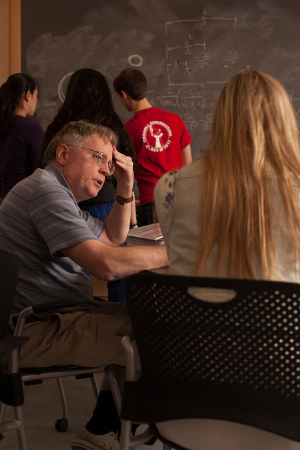New teaching model a 'game changer'
By Linda B. Glaser

Hundreds of students have just completed new courses in the College of Arts and Sciences’ Active Learning Initiative (ALI), part of a strategic effort by the college to embrace engaged learning models and emerging technologies. The ALI five-year pilot project is funded by Alex and Laura Hanson, both Class of 1987.
ALI uses a “flipped classroom” approach: Knowledge transfer happens before class, through assigned reading material or videos. Class time is then used for “deliberate practice,” applying the new knowledge via problem-solving and reasoning to give students experience making and testing predictions and solving problems. Studies have shown that the deliberate practice model is the quickest path to expert-level mastery of a given skill set.
“Because the College of Arts and Sciences teaches foundational courses that all undergraduate students throughout the university take, we have the unique opportunity to impact undergraduate education throughout Cornell with this initiative,” says Gretchen Ritter, the Harold Tanner Dean of Arts and Sciences. “We’re harnessing the passion and commitment from both faculty and alumni to institute these initiatives and expand our efforts to other foundational courses throughout the college.”
Physics and biology, the pilot departments for ALI, each converted large course sequences to the new model and reach almost 3,000 students. Jed Sparks, professor of ecology and evolutionary biology and ALI project lead for biology, said the initiative is “not fixing bad or broken classes but ones that are well-received – making something that works well work even better.”
Advanced students in ALI courses benefit from the deeper level at which the courses operate beyond basic knowledge transfer; midrange students have more opportunity to develop expert-level skills through greater exposure to more material; and the least prepared students benefit from improved opportunities to engage the course material, develop and practice skills, and close achievement gaps more quickly.
“ALI is a perfect example of Cornell’s dedication to taking our long history of excellent education into the future,” says Tomás Arias, associate professor and ALI project lead for physics. “We’re helping our students improve their level of retention and be better prepared to compete in the global intellectual marketplace.”
The College of Arts and Sciences is partnering with the Center for Teaching Excellence (CTE) in ALI. “Research and our own experience tell us that these interactive techniques contribute to enhanced learning,” says Theresa Pettit, CTE director. “What is particularly exciting about ALI is that it is a coordinated effort to build engaged learning into the curriculum at the departmental level with the potential to expand across campus.”
Developing the curricula for the pilot classes requires re-examining lecture objectives and what material should be covered, says Sparks. “For the active learning model to be successful, the teacher must have very clearly in mind what the teaching objectives for the class are. It requires them to teach in a more deliberate and intentional way. It’s transformative.”
The new learning model expects more of students as well as teachers, says Arias. “They must have the discipline to do their preparation before class, but by doing so, we can take them further and deeper than we could before.”
Student evaluations of the biology class were overwhelmingly positive. One student noted that the ALI approach boosted his confidence in the class; others singled out peer learning opportunities for praise. Students said response technologies like iClicker, which enable the teacher to poll the students, helped them to think critically about the material and to apply theory to practical examples.
Another benefit of response technologies is direct, frequent pedagogical assessment, says Lisa Sanfilippo, a teaching support specialist for the biology initiative. “Ongoing assessment is a key element of active learning,” she says.
Senior lecturer Phil Krasicky, who designed the pilot ALI physics course curriculum with associate professor Julia Thom-Levy, has been using clicker technology in class for years. “It’s the only way you have a sense of what the students are thinking,” he says, “and it gives the students a way to self-evaluate their own thinking and what they have learned.” He has seen significant improvement in the percentage of correct answers in his ALI physics classes.
Professors in the pilot classes also use other audience response systems. Biology professor Alex Flecker’s Poll Anywhere allows students to use their cell phones to respond to questions from the professor. Arias will use a Learning Catalytics program that enables students to use any smart device to respond to questions with equations, drawings and words. The technology also gives the instructor a map of the room, revealing which groups of students are having difficulties.
Thom-Levy noted nearly full attendance at every ALI physics lecture and said even students in the back row – normally the refuge of the disengaged – were actively involved in the class.
“What sold me on the active learning mode,” says Arias, “is that it gave us more time in class to share the joy of doing physics – because at the end of the day, people learn when they’re happy and engaged.”
Thom-Levy agrees. “I would never go back to the old approach,” she says. “Active learning is a game changer in teaching.”
In addition to CTE, the Learning Strategies Center, Cornell Information Technologies, and the Center for the Integration of Research, Teaching and Learning also support ALI.
Linda B. Glaser is a staff writer for the College of Arts and Sciences.
Media Contact
Get Cornell news delivered right to your inbox.
Subscribe